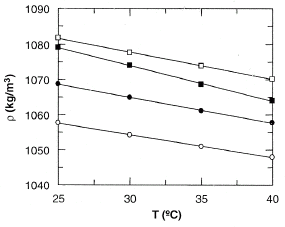Abstract
The rheological properties of four types of powdered baby foods have been investigated. Density and apparent viscosity have been measured at different temperatures. The values of the both properties decrease with the temperature. The experimental data belonging to apparent viscosity are represented by a power law. The relationship between the power law parameters and temperature has been analyzed.
Introduction
The knowledge of the rheological properties is important for design and evaluation of the process, process control,Citation1–3 consumer acceptability of a product,Citation[4] and the optimization of process variables. The physical properties of raw materials and transformed substrates have a great importance, as by intrinsic factors of quality as by the form in which such properties conditionate the manipulations and manufacturing or domestic transformations that the raw materials experience until becoming products ready for the consumption, without forgetting fashion, culture, and their organoleptic characteristics.Citation[5] Food is the base or the physical vehicle of the essential nutritional principles in life, and at the same time it is a robust element of entailment for determined life forms.
A great amount of powdered foods are mixtures of basic ingredients, nutrients and agents which provide flavor and other compounds with specific functionality. The aim of powdered food preparation is to increase its life utility, making agile its handling and storage and facilitating the preparation for its consumption.Citation[6] The analysis and the quantification of the rheological behavior of foods and the investigation of the chemical and structural causes determining them have a great interest in the food science and it is important to establish relationships between structure and flow, and to correlate physical parameters.Citation[7] Citation[8] In addition, the importance of rheological knowledge is also economic and commercial. The effects of transport and manipulation upon the physical integrity of fresh or cooked foods, their behavior during the processes of elaboration and texture quality of the product depend on their answer when external forces are applied,Citation[9] but also on shear rate and time of shearing.Citation[10] Almost all food is heat-treated before being eaten. During the heating process a lot of different physical, chemical, and structural changes take place,Citation[11] for example diffusion of heat and water, gelatinization of starch, denaturalization of proteins, formation of aroma compounds, and so on.
Drying is currently used in the food industry to dry heavy pastes and thick liquids, as cooked starch, baby food, mashed potatoes, concentrated liquids, caseinates, malt-dextrins, yeast creams, fruit pulps, etc. The obtained dried product is porous, easy to rehydrate and ready to use.Citation[12]
Baby foods are elaborated with some different products, such as flours with or without gluten, honey, fruits, etc. They are enriched with iron, calcium, and vitamins. The advantages of these foods are great nutritional quality, good digestibility, fast preparation without lumps, stable consistency, and excellent flavor.
Various studies have paid attention at the application of honey as a food ingredient, acting as a sweetener, flavor, humectant, and source of reducing sugars.Citation[13] Citation[14] These functional properties can be attributed to the high concentration of sugars present in honey; however, the minor constituents can also play a role, for example, as an antimicrobial,Citation[15] antioxidant,Citation[16] antibrowning,Citation[17] or antistaling agent.Citation[18] Another studies concluded that a gradual loss of gluten in the foods provokes a reduction of viscoelastic properties of flour.Citation[19]
In this work, the rheological behavior of four types of powdered baby foods with and without gluten or honey was investigated. Besides the effect of temperature on the apparent viscosity, density was measured. The results are tested via different rheological models.
Materials and Methods
The employed baby foods were: cereals flour with honey, flour with cocoa, flour without gluten, and rice flour. These were obtained from a local supermarket. All of these were prepared by dissolving 25 g of the solid food in 150 mL of warm deionized water. The ingredients of cereals flours with honey were: flours 91 wt% (wheat, hydrolyzed wheat, maize, barley, rye, miller, rice, sorghum, and oats), sugar, honey, (7 wt%), calcium and iron mineral salts, vitamins and flavor. The ingredients of flour with cocoa were: dextrinated cereal flours 67 wt% (wheat, rice, oats, barley, rye), cocoa 19 wt% (sugar, powder cocoa, kolamalteated cereal cream: flour of wheat, extract of malt, natural flavor: extract of nut of tail, calcium phosphate, flavors, salt) sugar, fructoligosacarids 3 wt%, mineral salt and vitamins. The ingredients of flour without gluten were: flours of dextrinated cereals 81 wt% (rice, maize) dextrinose, sugar, fructoligosacarids 3 wt%, mineral salts (calcium phosphate, ferrous sulphate), vitamins and flavor. The ingredients of rice flour were: flours 95 wt% (of rice and hydrolyzed rice), sugar, mineral salts of calcium and iron, vitamins and flavor. It does not contain gluten. The amount of vitamins and minerals of all the foods are shown in Table .
Table 1 Nutritional information per 100 g of food
Physical Properties Measurement
The density was determined using 25 cm3 pycnometer of the Gay-Lussac type from 25 to 40°C. The pycnometer containing the solution were thermostated to maintain a constant temperature with a precision of ± 0.05°C. They were weighed with the same balance. Each density value was the average of at least five measurements.
The rotational, concentric cylinder viscosimeter (Viscotester VT550, Germany) was used in this study. It is Searle type, in which the outer cylinder is fixed and the inner cylinder rotates. This apparatus measures the shear rate and the apparent viscosity of a fluid at a certain temperature. The apparent viscosity, η, is defined as the ratio of shear stress, τ, to that of shear rate, γ, (η = τ/γ), which was varied between 20 and 500 s−1. The SV1 sensor system was used (bob length = 61.4 mm, bob diameter = 20.2 mm, gap width = 1.45 mm). This system is usually used for apparent viscosity measurements of high viscosity liquids and pastes such as greases, creams, ointments, plastisols, etc., working in the low medium shear rate range. The amount of sample to be used must be adjusted in order for the top surface or the inner cylinder to be just covered. The temperature of this system was kept constant by means of a thermal liquid circulator and it is varied from 25 to 40°C.
Results and Discussions
Density
In this work the density, ρ, of the different substances was measured at different temperatures. The food with higher value is the flour without gluten and the one with lower value is the cereal flour with honey (Fig. ). Density decreases lineally with the temperature for all foods.
Table 2 Relationship between density and temperature
Apparent Viscosity
The apparent viscosity, η, of the different kind of baby foods was tested at various shear rates at different temperatures. From this, plots of shear stress vs. shear rate can be obtained at the four different temperatures. Some of these plots are shown in Figs. and for the four foods at the same temperature. If these figures are compared, we can observe that there is a decrease in shear stress when the temperature increases. The suspensions exhibited non-Newtonian and pseudoplastic behavior and therefore η must decrease with the shear rate and with the temperature (Figs. and ). The temperature dependency can be represented by means of the following Arrhenius-type equation:
Table 3 Activation energy, ΔE in J/mol, for all tested foods
Table 4 Relationship between η 0 and shear rate
Figure 2 Shear stress vs. shear rate for the tested baby foods at 30°C: cereals with honey (•), with cocoa (○), without gluten (□), rice (▪).
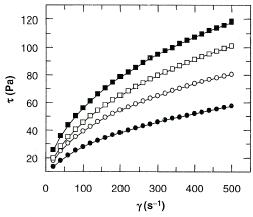
Figure 3 Shear stress vs. shear rate for the tested baby foods at 35°C: cereals with honey (•), with cocoa (○), without gluten (□), rice (▪).
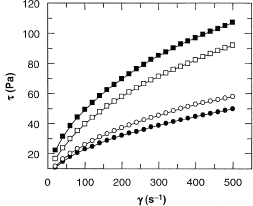
Figure 4 Viscosity vs. shear rate for all foods at 30°C: cereals with honey (•), with cocoa (○), without gluten (□), rice (▪).
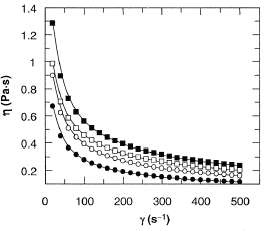
Figure 5 Viscosity vs. shear rate for all foods at 35°C: cereals with honey (•), with cocoa (○), without gluten (□), rice (▪).
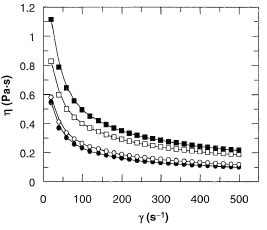
In this study, two models were used to represent the rheological data. These are:
Table 5 Power law parameters
The Power-law parameters changed with temperature. The behavior index, n, increases lineally with temperature, while the consistence index, K, decreases lineally when the temperature increases.
Table 6 Relationship between model parameters and temperature
Conclusions
Four analyzed baby foods have a non-Newtonian behavior and the temperature influences the values of apparent viscosity and density. The power law was used to fit the apparent viscosity data; this indicates that the examined materials are pseudoplastic fluids. The four baby foods have rice as one of its ingredients and the results lead us to conclude that the density and apparent viscosity increase with the amount of rice. The tested powered baby foods without gluten, flour without gluten, and rice flour, have a higher viscosity and density than the flours with honey or cocoa. When we establish comparisons between foods with gluten, we observed that the flour with cocoa has higher values of both physical properties.
References
- Brennan , J.G. , Butters , J.R. , Cowell , N.D. and Lilly , A.E.V. 1980 . Las Operaciones De la Ingeniería de Los Alimentos, , Ed. Zaragoza, , Spain : Acribia .
- Dail , R.V. and Steffe , J.F. 1990a . Rheological characterization of cross-linked waxy maize starch solutions under low acid aseptic processing conditions using tube viscosimetry techniques . Journal of Food Science , 9 : 151 – 191 .
- Dail , R.V. and Steffe , J.F. 1990b . Dilatancy in starch solutions under low acid aseptic processing conditions . Journal of Food Science , 55 : 1764 – 1765 .
- Harrison , L. and Cunningham , F. 1985 . Factors influencing the quality of mayonnaise: a review . Journal of Food Quality , 8 : 1 – 20 .
- Bueno de las Heras , J.L. 2002 . Propiedades de los alimentos (III) fundamentos y convencionalismos en la definición de propiedades . Química e Industria , 49 ( 9 ) : 26 – 36 .
- Rao , M.A. and Steffe , J.F. 1992 . Viscoelastic Properties of Foods, , Ed. Elsevier Applied Science .
- Abu-Jdayil , B. 2003 . Modelling the time-dependent rheological behavior of semisolid foodstuffs . Journal of Food Engineering , 57 : 97 – 102 .
- Resch , J.J. 2002 . Rheological and physocochemical properties of derivatized whey protein concentrate powders . International Journal of Food Properties , 5 ( 2 ) : 419 – 434 .
- Aguilera , J.M. 1997 . Temas en Tecnología de los Alimentos Barcelona, , Spain : Instituto Politécnico Nacional .
- Tiu , C. and Boger , D.V. 1974 . Complete rheological characterization of time-dependent products . Journal of Texture Studies , 5 : 329 – 338 .
- Thorvaldson , K. , Stading , M. , Nilsson , K. , Kidman , S. and Langton , M. 1999 . Rheology and structure of heat-treated pasta dough: influence of water content and heating rate . Lebensmittel-Wissenschaft und -Technologie , 32 : 154 – 161 .
- Rodriguez , G. , Vasseur , J. and Courtois , F. 1996 . Design and control of drum dryers for the food industry . Journal of Food Engineering , 28 : 271 – 282 .
- Torley , P.J. , Rutgers , R.P.G. , D’Arcy , B. and Bhandari , B.R. Effect of honey types and concentration on starch gelatinization . Lebensmittel-Wissenschaft und - Technologie , in press
- Zaitoun , S. , Ghzawi , A. , Al-Malah , K. and Abu-Jdayil , B. 2001 . Rheological properties of selected light colored Jordain honey . International Journal of Food Properties , 4 ( 1 ) : 139 – 148 .
- Bogdanov , S. 1997 . Nature and origin of the antibacterial substances in money . Lebensmittel-Wissenschaft und -Technologie , 30 : 748 – 753 .
- Gheldof , N. , Wang , X.H. and Engeseth , N.J. 2002 . Identification and quantification of antioxidant components of honeys from various floral sources . Journal of Agricultural and Food Chemistry , 50 : 5870 – 5877 .
- Chen , L. , Metha , A. , Berenbaum , M. , Zangerl , A. and Engeseth , N.J. 2000 . Honeys from different floral sources as inhibitors of enzymatic browning in fruit and vegetable homogenates . Journal of Agricultural and Food Chemistry , 48 : 4997 – 5000 .
- D’Arcy , B. , Caffin , N. , Bhandari , B. , Squires , N. , Fedorow , P. and Mackay , D. Australian Liquid Honey in Commercial Bakery Products , Project Report 99/145 . Rural Industries Research and Development Corporation: Canberra, Australia, 1999
- Khalil , A.H. , Mansour , E.H. and Dawoud , F.M. 2000 . Influence of malt on rheological and baking properties of wheat-cassava composite flours . Lebensmittel-Wissenschaft und -Technologie , 33 : 159 – 164 .
